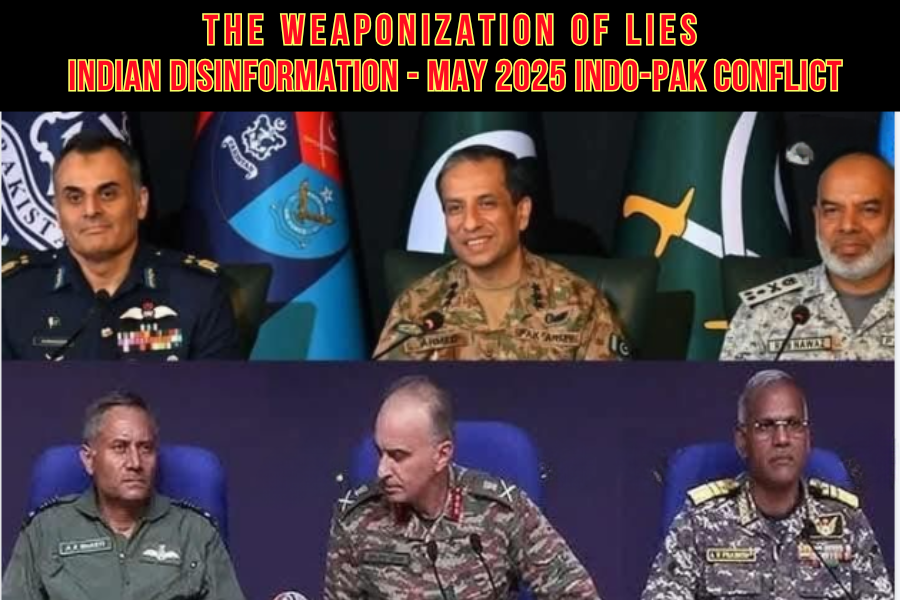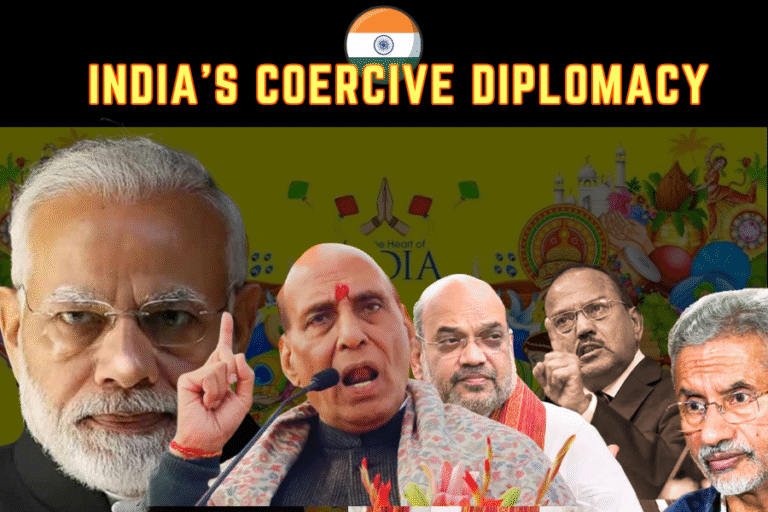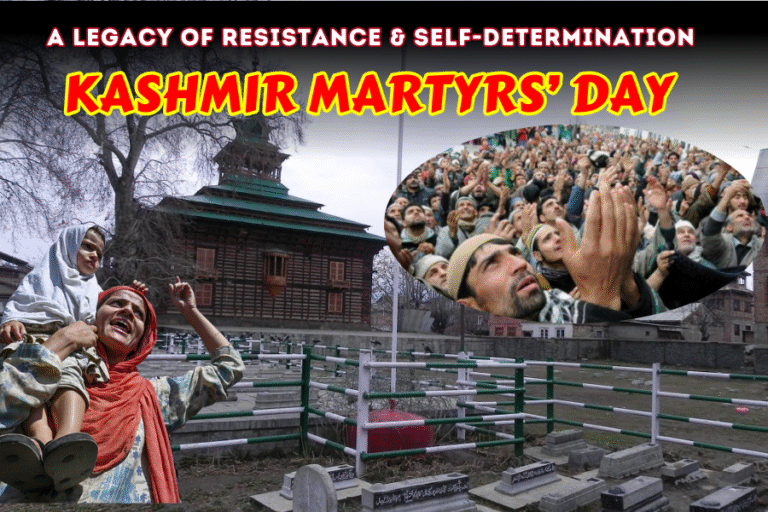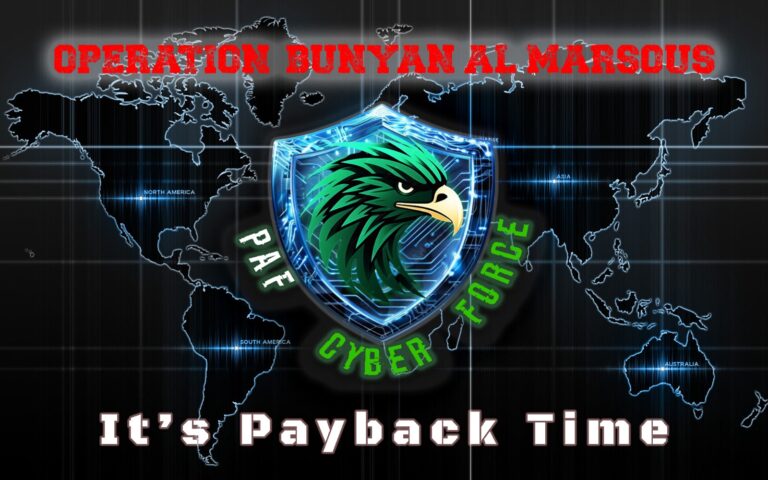(By Khalid Masood)
I. Introduction
On 22 April 2025, the Pahalgam attack in Jammu and Kashmir claimed 26 civilian lives, triggering a brief but intense Indo-Pak conflict from 7 to 10 May 2025, codenamed Operation Sindoor by India and Muarka-e-Baqa by Pakistan in retaliation. This escalation, driven by Indian airstrikes on Pakistan and Azad Kashmir, unfolded alongside a fierce digital campaign where India employed disinformation, including AI-generated content, deepfakes, recycled footage, and fabricated news reports, to shape domestic and international narratives while concealing its significant military losses. This article examines India’s strategic use of disinformation as a tool of statecraft, its domestic and global repercussions, and the lessons for Pakistan.
II. The Pahalgam Attack: Prelude to Disinformation
On 22 April 2025, terrorists struck Baisaran Valley in Pahalgam, Jammu and Kashmir, killing 25 tourists and one local resident in one of the region’s deadliest attacks in recent years. Indian authorities and media swiftly attributed the assault to a Pakistan Inter-Services Intelligence (ISI) and Lashkar-e-Taiba plot, alleging it was orchestrated by a former Pakistani commando with no local involvement, drawing parallels to the 2008 Mumbai attacks. India accused Pakistan’s political and military leadership of direct complicity, justifying a temporary suspension of the Indus Waters Treaty and the launch of Operation Sindoor on 7 May. Pakistan’s Prime Minister denounced the attack as tragic, firmly rejected state involvement, and accused India of exploiting the incident to undermine regional stability. India’s initial narrative, lacking verified evidence, framed Pakistan as the sole aggressor, setting the stage for a broader disinformation campaign to amplify nationalistic sentiment and obscure military setbacks.
III. Operation Sindoor: Claims vs. Reality
Operation Sindoor, launched in the pre-dawn hours of May 7, 2025, was a high-profile Indian Air Force offensive targeting nine alleged terrorist camps in Pakistan and Pakistan-occupied Kashmir (PoK), including key sites in Muridke, Bahawalpur, Muzaffarabad, and Kotli. The operation deployed advanced Rafale, Mirage 2000, and Su-30 MKI jets, armed with BrahMos supersonic cruise missiles, SCALP (Storm Shadow) missiles, AASM Hammer glide bombs, and Israeli-made Spice-2000 precision munitions, alongside Indo-Israeli SkyStriker loitering munitions. Indian National Security Advisor Ajit Doval hailed the strikes as a “flawless” demonstration of India’s indigenous technology, claiming pinpoint accuracy with “zero collateral damage” and no Indian losses, daring foreign media to produce evidence of even “a broken glass pane.” Indian media, including The Times of India and India Today, celebrated the operation as a decisive blow, reporting the complete destruction of Lashkar-e-Taiba’s Markaz Taiba in Muridke—linked to the 2008 Mumbai attacks—and Jaish-e-Mohammed’s Jamia Masjid Subhan Allah in Bahawalpur, with unverified claims that Jaish leader Abdul Rauf Azhar was killed. However, Pakistan’s open-source intelligence (OSINT), supported by Maxar Technologies’ satellite imagery, painted a starkly different picture, revealing minimal damage to military targets and significant civilian casualties, including at least 31 deaths, among them 10 relatives of Jaish leader Masood Azhar, including five children, and eight civilians at Muridke’s educational complex. Pakistan’s Inter-Services Public Relations (ISPR) reported damage to civilian infrastructure, such as mosques in Muzaffarabad and Kotli, contradicting India’s narrative of surgical precision. Indian Deputy Chief of Army Staff Lt Gen Rahul R Singh later admitted to the loss of three Rafale jets, one Mirage 2000, and two S-400 air defence units in retaliatory Pakistani strikes on Indian airbases like Sirsa and Adampur, undermining initial denials. Fact-checking by independent outlets exposed India’s reliance on disinformation, including AI-generated deepfakes depicting Pakistan’s Prime Minister falsely admitting defeat and recycled footage from 2023 Gaza airstrikes misrepresented as strikes on Karachi Port. These fabrications, aimed at stoking nationalistic fervor and countering China’s narrative against Rafale performance, inflated Operation Sindoor’s success to mask strategic failures and bolster domestic support, highlighting India’s use of asymmetric warfare tactics that threaten regional stability and Pakistan’s CPEC security and maritime security interests.
IV. The Disinformation Ecosystem
a. AI-Generated Content and Deepfakes
Indian media and social platforms circulated AI-generated deepfakes, including a video of Pakistan’s Prime Minister falsely admitting defeat and Islamabad’s capture. Original footage showed the Prime Minister praising Pakistan’s response. Deepfakes of Indian leaders apologizing were also debunked, highlighting India’s use of AI-generated content to manipulate perceptions.
b. Recycled and Misattributed Footage
Indian outlets used recycled footage from 2023 Gaza airstrikes and Iran’s attacks on Israel, presenting them as Operation Sindoor strikes on Karachi Port and Lahore. Clips from video games and unrelated Pakistani clashes were falsely labeled as Noor Khan Airbase attacks. Fact-checking identified these as misattributed, undermining India’s narrative.
c. Fabricated News Reports
Indian media claimed Pakistan’s airbases were destroyed without evidence, while Pakistan’s military and local journalists showed minimal damage and civilian casualties. Foreign intelligence suggested India exaggerated to counter China’s narrative against Rafale performance, aiming to bolster domestic support.
V. Domestic Implications of Disinformation
Indian disinformation stoked nationalistic fervor, with media portraying Operation Sindoor as a decisive victory, rallying public support for the government. Social media amplified AI-generated content, with many posts inflaming communal sentiments. However, revelations of recycled footage and deepfakes eroded trust, with opposition leaders questioning the government’s silence on U.S.-brokered ceasefire claims. Critics accused the government of masking losses, fracturing societal cohesion. The Indian Army’s post-conflict narrative warfare training reflects acknowledgment of these failures. For Pakistan, this underscores the need for robust CPEC security to counter India’s narrative-driven asymmetric warfare.
VI. International Repercussions
Globally, India’s disinformation campaign damaged its credibility. Pakistan’s open-source intelligence provided verified evidence of civilian casualties, countering Indian claims at international forums. Reports highlighted India’s reliance on deepfakes, prompting calls for information integrity frameworks. China exploited Indian exaggerations to discredit Rafale jets, affecting India’s arms market in Southeast Asia. U.S. and NATO allies, while supporting India’s anti-terror stance, expressed concerns over misinformation, with U.S. claims of brokering the ceasefire undermining India’s narrative of dominance. For Pakistan, this reinforces the importance of Pakistan naval strategy and maritime security to protect CPEC routes amid regional mistrust.
VII. Ethical and Strategic Considerations
Using disinformation as statecraft raises ethical concerns. India’s AI-generated content and fabricated news reports manipulated public sentiment but risked long-term trust in democratic institutions, as seen in domestic backlash. Strategically, Operation Sindoor’s inflated success, debunked by fact-checks, mirrors past Pakistani denials, showing short-term gains but long-term diplomatic costs. Disinformation escalates conflicts by obscuring truth, undermining international norms. Pakistan must counter such tactics with open-source intelligence and narrative warfare, protecting CPEC security and maritime security against India’s digital aggression. Globally, the 2025 conflict highlights the need for regulatory frameworks to penalize deliberate misinformation.
VIII. Conclusion
India’s disinformation campaign during the May 2025 Indo-Pak conflict, from AI-generated deepfakes to recycled footage, amplified Operation Sindoor’s perceived success but crumbled under scrutiny. Exaggerated claims, countered by Pakistan’s open-source intelligence, damaged India’s global credibility and domestic cohesion. The Pahalgam attack and subsequent digital war underscore disinformation’s role in asymmetric warfare, urging Pakistan to bolster CPEC security and Pakistan naval strategy. Recommendations include global frameworks for information integrity, media literacy to spot deepfakes, and investment in real-time fact-checking. The 2025 conflict is a wake-up call: truth is the first casualty in modern warfare, and safeguarding it is paramount.







